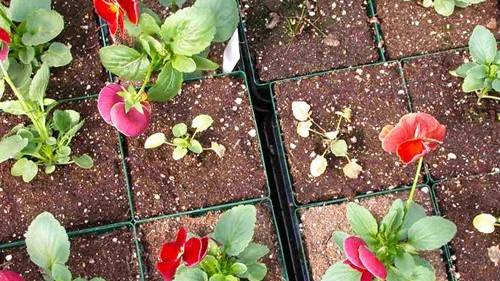Root Disease Profile: Thielaviopsis


Thielaviopsis root rot, caused by the fungal pathogen Thielaviopsis basicola, can occur in over 150 species of greenhouse and perennial crops, including astilbe, begonia, calla lilies, calibrachoa, cyclamen, fuchsia, gaillardia, geranium, gerbera, kalanchoe, lupine, pansy, penstemon, peony, petunia, phlox, poinsettia, primula, snapdragon, strawberry, sweet pea, tobacco, tomato, verbena, vinca and viola. Thielaviopsis root rot is characterized by dark brown or blacked spores within the root, followed by black lesions on the root, which give the characteristic name of “black root rot”. It is a difficult disease to control once it is started, so it is best to discard infected plants. Crop loss from Thielaviopsis can be quite extensive if not controlled.
Symptoms
A crop that has Thielaviopsis root rot will show overall irregular growth with stunted, infected plants next to normal plants. Infected plants will become chlorotic or purpled as if the plants need fertilizer. Examine the roots for brown or black rotted areas, as rotting roots cannot acquire nutrients. Within an infected root, Thielaviopsis produces dark brown to black, thick-walled barrel-shaped chlamydospores, which are reproductive, resting spores. Although microscopic, these chlamydospores are produced in large enough numbers, causing sections of the root to look black. Black lesions also form on the root, adding to the dark brown/black coloration of the roots. With severe infections, plants wilt even when the growing medium is wet.

Favourable Conditions
Keeping the growing medium consistently very moist to wet from overwatering creates ideal conditions for Thielaviopsis. High humidity and lack of airflow within the crop further contribute to poor dry-out of the growing medium. Thielaviopsis prefers cool growing media temperatures around 55-61 °F (13-16 °C). Only a trace amount of Thielaviopsis is found when the temperature of the growing medium is at or above 86 °F (30 °C). It also prefers less acidic or alkaline growing media. If the pH is 5.5 or less, Thielaviopsis is greatly reduced, and below 4.8, it is almost non-existent.
Thielaviopsis is an opportunistic pathogen that attacks plants under stress. Keeping the growing medium continuously wet, along with low light, and humid conditions, causes plant stress. Other factors, such as fertilizing at insufficient or excessive rates, insect infestations, fungal attacks, improper temperatures, and rough handling of crops, all contribute to plant stress and increased crop susceptibility to Thielaviopsis.
Pathogen Source
Like many soil-borne pathogens, Thielaviopsis often comes into the greenhouse from outside. Outdoor soil contains pathogens, and when the dust from soil or equipment that was in contact with soil is used with growing media, the chlamydospores easily inoculate the growing medium. If Thielaviopsis has been a problem in the previous year, chlamydospores can persist in the greenhouse or soil for years. Chlamydospores are sticky and adhere to many surfaces, including containers, equipment, benches, and other structural surfaces. If these surfaces are not properly sanitized, then Thielaviopsis root rot can occur in future crops.
Other sources can include the introduction of infected rooted cuttings, plugs or prefinished plants into the greenhouse. Fungus gnats and shore flies are known to vector Thielaviopsis from one crop to another. Thielaviopsis also produces weaker endoconidia that are easily spread from plant to plant from splashing water during watering.
Cultural Controls
Many factors create ideal conditions for Thielaviopsis root rot. The most important cultural control methods relate to proper sanitation and avoiding plant stress. The following tips can be used to minimize Thielaviopsis in greenhouse crops:
- Do not reuse containers. If you must reuse containers, use them for crops that are not susceptible to Thielaviopsis.
- Clean growing media and other debris from benches, walls, glazing, floors, equipment, etc., and then sanitize all surfaces.
- Use a well-drained growing medium, such as PRO-MIX HP® MYCORRHIZAE™ + BIOFUNGICIDE™. Although BIOFUNGICIDE™ is not listed for Thielaviopsis, both ingredients will reduce plant stress and can reduce the incidence of Thielaviopsis.
- Maintain growing media temperatures above 70 °F (21 °C) to minimize Thielaviopsis activity.
- Avoid overwatering by allowing the surface of the growing medium to dry between irrigations.
- If appropriate for the crop, maintain the pH of the growing medium at 5.5 or less.
- Control fungus gnats and shore flies that vector Thielaviopsis.
- Increase airflow to help dry out growing media.
- Reduce stress on plants by fertilizing at appropriate rates, controlling insects and diseases, and growing at optimal temperatures for the crop.
- Do not lay water breakers on floors where Thielaviopsis can be found.
There are several chemicals and biological organisms that can reduce or control Thielaviopsis; please consult with your distributor or local extension for more information. For more information about how root diseases impact crops grown in PRO-MIX, please consult your Premier Tech Grower Services Specialist.
References:
https://extension.psu.edu/black-root-rot-thielaviopsis
https://www.canr.msu.edu/news/thielaviopsis_symptoms_and_control
http://plantclinic.cornell.edu/factsheets/blackrootrot.pdf